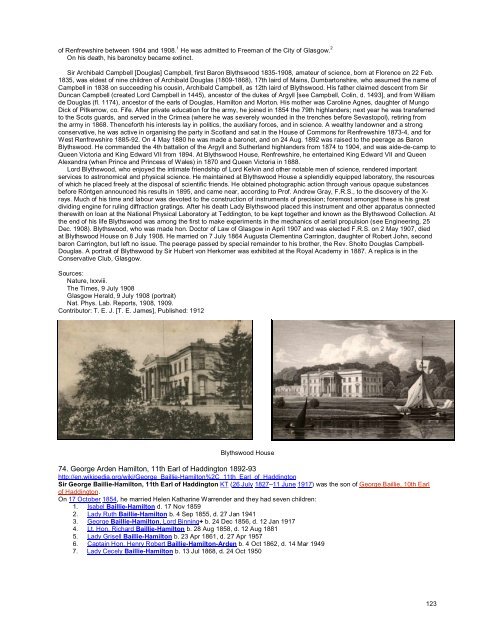Grand Masters of Scotland - Onondaga and Oswego Masonic ...
Grand Masters of Scotland - Onondaga and Oswego Masonic ...
Grand Masters of Scotland - Onondaga and Oswego Masonic ...
Create successful ePaper yourself
Turn your PDF publications into a flip-book with our unique Google optimized e-Paper software.
<strong>of</strong> Renfrewshire between 1904 <strong>and</strong> 1908. 1 He was admitted to Freeman <strong>of</strong> the City <strong>of</strong> Glasgow. 2<br />
On his death, his baronetcy became extinct.<br />
Sir Archibald Campbell [Douglas] Campbell, first Baron Blythswood 1835-1908, amateur <strong>of</strong> science, born at Florence on 22 Feb.<br />
1835, was eldest <strong>of</strong> nine children <strong>of</strong> Archibald Douglas (1809-1868), 17th laird <strong>of</strong> Mains, Dumbartonshire, who assumed the name <strong>of</strong><br />
Campbell in 1838 on succeeding his cousin, Archibald Campbell, as 12th laird <strong>of</strong> Blythswood. His father claimed descent from Sir<br />
Duncan Campbell (created Lord Campbell in 1445), ancestor <strong>of</strong> the dukes <strong>of</strong> Argyll [see Campbell, Colin, d. 1493], <strong>and</strong> from William<br />
de Douglas (fl. 1174), ancestor <strong>of</strong> the earls <strong>of</strong> Douglas, Hamilton <strong>and</strong> Morton. His mother was Caroline Agnes, daughter <strong>of</strong> Mungo<br />
Dick <strong>of</strong> Pitkerrow, co. Fife. After private education for the army, he joined in 1854 the 79th highl<strong>and</strong>ers; next year he was transferred<br />
to the Scots guards, <strong>and</strong> served in the Crimea (where he was severely wounded in the trenches before Sevastopol), retiring from<br />
the army in 1868. Thenceforth his interests lay in politics, the auxiliary forces, <strong>and</strong> in science. A wealthy l<strong>and</strong>owner <strong>and</strong> a strong<br />
conservative, he was active in organising the party in <strong>Scotl<strong>and</strong></strong> <strong>and</strong> sat in the House <strong>of</strong> Commons for Renfrewshire 1873-4, <strong>and</strong> for<br />
West Renfrewshire 1885-92. On 4 May 1880 he was made a baronet, <strong>and</strong> on 24 Aug. 1892 was raised to the peerage as Baron<br />
Blythswood. He comm<strong>and</strong>ed the 4th battalion <strong>of</strong> the Argyll <strong>and</strong> Sutherl<strong>and</strong> highl<strong>and</strong>ers from 1874 to 1904, <strong>and</strong> was aide-de-camp to<br />
Queen Victoria <strong>and</strong> King Edward VII from 1894. At Blythswood House, Renfrewshire, he entertained King Edward VII <strong>and</strong> Queen<br />
Alex<strong>and</strong>ra (when Prince <strong>and</strong> Princess <strong>of</strong> Wales) in 1870 <strong>and</strong> Queen Victoria in 1888.<br />
Lord Blythswood, who enjoyed the intimate friendship <strong>of</strong> Lord Kelvin <strong>and</strong> other notable men <strong>of</strong> science, rendered important<br />
services to astronomical <strong>and</strong> physical science. He maintained at Blythswood House a splendidly equipped laboratory, the resources<br />
<strong>of</strong> which he placed freely at the disposal <strong>of</strong> scientific friends. He obtained photographic action through various opaque substances<br />
before Röntgen announced his results in 1895, <strong>and</strong> came near, according to Pr<strong>of</strong>. Andrew Gray, F.R.S., to the discovery <strong>of</strong> the X-<br />
rays. Much <strong>of</strong> his time <strong>and</strong> labour was devoted to the construction <strong>of</strong> instruments <strong>of</strong> precision; foremost amongst these is his great<br />
dividing engine for ruling diffraction gratings. After his death Lady Blythswood placed this instrument <strong>and</strong> other apparatus connected<br />
therewith on loan at the National Physical Laboratory at Teddington, to be kept together <strong>and</strong> known as the Blythswood Collection. At<br />
the end <strong>of</strong> his life Blythswood was among the first to make experiments in the mechanics <strong>of</strong> aerial propulsion (see Engineering, 25<br />
Dec. 1908). Blythswood, who was made hon. Doctor <strong>of</strong> Law <strong>of</strong> Glasgow in April 1907 <strong>and</strong> was elected F.R.S. on 2 May 1907, died<br />
at Blythswood House on 8 July 1908. He married on 7 July 1864 Augusta Clementina Carrington, daughter <strong>of</strong> Robert John, second<br />
baron Carrington, but left no issue. The peerage passed by special remainder to his brother, the Rev. Sholto Douglas Campbell-<br />
Douglas. A portrait <strong>of</strong> Blythswood by Sir Hubert von Herkomer was exhibited at the Royal Academy in 1887. A replica is in the<br />
Conservative Club, Glasgow.<br />
Sources:<br />
Nature, lxxviii.<br />
The Times, 9 July 1908<br />
Glasgow Herald, 9 July 1908 (portrait)<br />
Nat. Phys. Lab. Reports, 1908, 1909.<br />
Contributor: T. E. J. [T. E. James], Published: 1912<br />
Blythswood House<br />
74. George Arden Hamilton, 11th Earl <strong>of</strong> Haddington 1892-93<br />
http://en.wikipedia.org/wiki/George_Baillie-Hamilton%2C_11th_Earl_<strong>of</strong>_Haddington<br />
Sir George Baillie-Hamilton, 11th Earl <strong>of</strong> Haddington KT (26 July 1827–11 June 1917) was the son <strong>of</strong> George Baillie, 10th Earl<br />
<strong>of</strong> Haddington.<br />
On 17 October 1854, he married Helen Katharine Warrender <strong>and</strong> they had seven children:<br />
1. Isabel Baillie-Hamilton d. 17 Nov 1859<br />
2. Lady Ruth Baillie-Hamilton b. 4 Sep 1855, d. 27 Jan 1941<br />
3. George Baillie-Hamilton, Lord Binning+ b. 24 Dec 1856, d. 12 Jan 1917<br />
4. Lt. Hon. Richard Baillie-Hamilton b. 28 Aug 1858, d. 12 Aug 1881<br />
5. Lady Grisell Baillie-Hamilton b. 23 Apr 1861, d. 27 Apr 1957<br />
6. Captain Hon. Henry Robert Baillie-Hamilton-Arden b. 4 Oct 1862, d. 14 Mar 1949<br />
7. Lady Cecely Baillie-Hamilton b. 13 Jul 1868, d. 24 Oct 1950<br />
123







![Richard [Nicholls] Harison / Harrison - Onondaga and Oswego ...](https://img.yumpu.com/24950065/1/190x245/richard-nicholls-harison-harrison-onondaga-and-oswego-.jpg?quality=85)
![Richard [Nicholls] Harison / Harrison - Onondaga and Oswego ...](https://img.yumpu.com/24950063/1/190x245/richard-nicholls-harison-harrison-onondaga-and-oswego-.jpg?quality=85)








